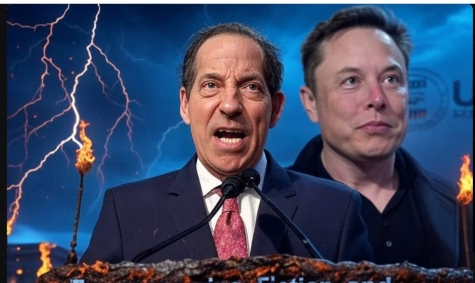Democrat Congressman Jamie Raskin’s latest tirade outside the USAID building was nothing short of a political stunt designed to whip up hysteria. In a theatrical performance worthy of an Oscar, Raskin painted Elon Musk as some shadowy puppet master, accusing him of single-handedly dismantling a government agency and seizing control of the U.S. Treasury’s financial systems. This isn’t just hyperbole—it’s outright fiction.
First, let’s get one thing straight: Elon Musk did not “illegally seize power” over the Treasury or USAID. That’s a wild accusation with zero evidence. USAID operates under executive authority, meaning if there’s a shift in funding or priorities, it’s coming from the top—the White House—not from a private citizen. Raskin, a so-called constitutional scholar, should know that. But instead of directing his outrage at the actual policymakers responsible, he chose to go after Musk, because nothing riles up the progressive base like a billionaire villain.
Raskin’s breathless warnings about people dying from a lack of USAID funding conveniently ignore the fact that America spends nearly a trillion dollars on its budget, with foreign aid being a small fraction of that. Yet, somehow, the supposed “obliteration” of a few billion dollars in programs is framed as the end of global humanitarianism. What he fails to mention is the rampant inefficiency and corruption that plagues USAID, where taxpayer dollars often get funneled into bloated NGOs with questionable results. Shouldn’t we be demanding accountability before blindly throwing more money at a broken system?
And let’s talk about his laughable assertion that we don’t have a “fourth branch of government called Elon Musk.” No kidding, Jamie! But we also don’t have a system where unelected bureaucrats run rogue with endless taxpayer money, immune from oversight. The idea that Musk is single-handedly orchestrating a coup against USAID is so detached from reality, it makes you wonder if Raskin actually believes what he’s saying, or if he’s just counting on the media to amplify his narrative without question.
At the end of the day, Raskin isn’t protecting democracy—he’s fearmongering for political gain. His speech was designed to stoke outrage, not to inform. If he were serious about solving problems, he’d be advocating for smarter, more effective foreign aid—not screaming about an imaginary Musk dictatorship.
Watch Raskin:
Watch Secretary of State Marco Rubio explain the problems with USAID:
Here are the details of the formation of USAID:
USAID has played a pivotal role in U.S. foreign policy for over 60 years, shaping global development and diplomacy. While it has contributed to economic growth, humanitarian relief, and democracy promotion, it has also faced criticism for its involvement in political and strategic agendas.
The United States Agency for International Development (USAID) was established on November 3, 1961, by President John F. Kennedy through Executive Order 10973. USAID was created to consolidate and coordinate U.S. foreign aid efforts, focusing on economic development, humanitarian assistance, and global stability. Below is a brief history of its evolution:
Origins and Formation (1948–1961)
- Post-World War II Aid: The U.S. played a major role in global reconstruction after WWII. The Marshall Plan (1948) provided economic assistance to help rebuild Western Europe, and similar programs supported Asia and Latin America.
- Foreign Assistance Act of 1961: Recognizing the need for a centralized aid organization, Congress passed this act, leading to the creation of USAID. The agency combined multiple aid programs under one roof.
Cold War Era (1960s–1980s)
- USAID became a tool of Cold War diplomacy, aiming to counter Soviet influence in developing nations through economic and technical assistance.
- The agency funded infrastructure projects, agricultural programs, and public health initiatives in regions like Latin America (through the Alliance for Progress) and Southeast Asia.
- USAID played a role in Vietnam War-era counterinsurgency efforts, supporting economic development to counter communist influence.
Post-Cold War and Globalization (1990s–2000s)
- After the Soviet Union collapsed, USAID shifted its focus from anti-communist efforts to promoting democracy, economic liberalization, and humanitarian relief.
- It provided assistance to post-Soviet states in Eastern Europe and the former USSR.
- USAID also responded to global crises such as HIV/AIDS, the Rwandan Genocide (1994), and post-war reconstruction in Bosnia and Kosovo.
War on Terror & Modernization (2001–2010s)
- Following 9/11, USAID became heavily involved in nation-building efforts in Afghanistan and Iraq, supporting reconstruction, governance, and economic development.
- The agency expanded humanitarian and development aid in Africa, launching initiatives like PEPFAR (HIV/AIDS relief) and the Millennium Challenge Corporation.
- In the 2010s, USAID responded to crises such as the Haiti earthquake (2010) and the Syrian refugee crisis.
Recent Years (2020s–Present)
- USAID continues to focus on global health, climate change, disaster relief, and democracy promotion.
- Under the Biden administration, USAID has emphasized COVID-19 response, Ukraine war assistance, and climate adaptation programs.
Controversies and Criticism
- Geopolitical Influence: Critics argue USAID has often been used as a soft power tool to advance U.S. geopolitical interests rather than purely humanitarian goals.
- Involvement in Regime Change: The agency has been accused of supporting political opposition groups in countries like Cuba, Venezuela, and Ukraine.
- Corruption and Mismanagement: Some programs have faced scrutiny over inefficiency, fraud, and wasteful spending.
